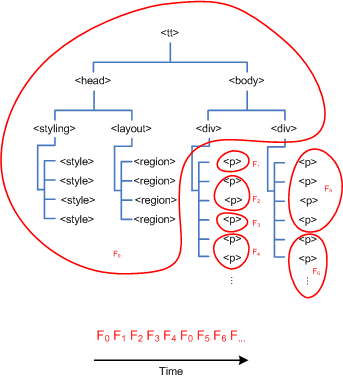8.2 Attribute Vocabulary
This section defines the style attribute used with both style
definition elements as well as content elements.
In addition, this section specifies the following attributes in the TT Style
Namespace for use with style definition elements, certain layout elements, and
content elements that support inline style specifications:
-
tts:backgroundColor
-
tts:color
-
tts:direction
-
tts:display
-
tts:displayAlign
-
tts:dynamicFlow
-
tts:extent
-
tts:fontFamily
-
tts:fontSize
-
tts:fontStyle
-
tts:fontWeight
-
tts:lineHeight
-
tts:opacity
-
tts:origin
-
tts:overflow
-
tts:padding
-
tts:showBackground
-
tts:textAlign
-
tts:textOutline
-
tts:unicodeBidi
-
tts:visibility
-
tts:wrapOption
-
tts:writingMode
-
tts:zIndex
Unless explicitly stated otherwise, linear white-space (LWSP) may appear
between tokens of a value of a TT Style Property.
Note:
This specification makes use of lowerCamelCased local names for
style attributes that are based upon like-named properties defined by [XSL 1.0]. This convention is likewise extended to token
values of such properties.
8.2.1
style
The style attribute is used to reference one or more
style elements each of which define a computed style
specification set.
The style attribute may be specified by an instance of the
following element types:
-
body
-
div
-
p
-
region
-
span
-
style
Note:
See the specific element type definitions that permit use of the
style attribute for further information on its semantics.
8.2.2 tts:backgroundColor
The tts:backgroundColor attribute is used to specify a style
property that defines the background color of a region or an area generated
by content flowed into a region.
This attribute may be specified by any style specification element or
content element that permits use of attributes in the TT Style Namespace;
however, this attribute applies as a style property only to those element
types indicated in the following table.
| Values: |
<color> | inherit |
| Initial: |
transparent |
| Applies to: |
region, body,
div, p, span |
| Inherited: |
no |
| Animatable: |
discrete |
The tts:backgroundColor style is illustrated by the following
example.
Example Fragment – Background Color
<region id="r1">
<style tts:extent="306px 114px"/>
<style tts:backgroundColor="red"/>
<style tts:color="white"/>
<style tts:displayAlign="after"/>
<style tts:padding="3px 40px"/>
</region>
...
<p region="r1" tts:backgroundColor="purple" tts:textAlign="center">
Twinkle, twinkle, little bat!<br/>
How <span tts:backgroundColor="green">I wonder</span> where you're at!
</p>
|
Example Rendition – Background Color
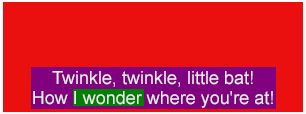 |
Note:
The semantics of the style property represented by this attribute are
based upon that defined by [XSL 1.0], § 7.7.2.
8.2.3
tts:color
The tts:color attribute is used to specify a style property
that defines the foreground color of marks associated with an area generated
by content flowed into a region.
This attribute may be specified by any style specification element or
content element that permits use of attributes in the TT Style Namespace;
however, this attribute applies as a style property only to those element
types indicated in the following table.
| Values: |
<color> | inherit |
| Initial: |
transparent |
| Applies to: |
span |
| Inherited: |
yes |
| Animatable: |
discrete |
Note:
For the purpose of determining applicability of this style property,
each character child of a p element is considered to be
enclosed in an anonymous span.
The tts:color style is illustrated by the following
example.
Example Fragment – Color
<region id="r1">
<style tts:backgroundColor="black"/>
<style tts:color="white"/>
<style tts:displayAlign="after"/>
<style tts:textAlign="center"/>
</region>
...
<p region="r1">
In spring, when woods are <span tts:color="green">getting green</span>,<br/>
I'll try and tell you what I mean.
</p>
|
Example Rendition – Color
 |
Note:
The semantics of the style property represented by this attribute are
based upon that defined by [XSL 1.0], § 7.17.1.
8.2.4 tts:direction
The tts:direction attribute is used to specify a style
property that defines the directionality of an embedding or override
according to the Unicode bidirectional algorithm.
This attribute may be specified by any style specification element or
content element that permits use of attributes in the TT Style Namespace;
however, this attribute applies as a style property only to those element
types indicated in the following table.
| Values: |
ltr | rtl |
inherit |
| Initial: |
ltr |
| Applies to: |
span |
| Inherited: |
yes |
| Animatable: |
none |
The tts:direction style is illustrated by the following
example.
Example Rendition – Direction
| Editorial note: GA |
2005-02-22 |
Provide example source
fragment and image for tts:direction style
property. |
|
Note:
The semantics of the style property represented by this attribute are
based upon that defined by [XSL 1.0], § 7.27.1.
8.2.5
tts:display
The tts:display attribute is used to specify a style property
that defines whether an element is a candidate for layout and composition in
a region.
This attribute may be specified by any style specification element or
content element that permits use of attributes in the TT Style Namespace;
however, this attribute applies as a style property only to those element
types indicated in the following table.
| Values: |
auto | none |
inherit |
| Initial: |
auto |
| Applies to: |
body, div,
p, span |
| Inherited: |
no |
| Animatable: |
discrete |
If the value of this attribute is auto, then the affected
element is a candidate for region layout and presentation; however, if the
value is none, then the affected element and its descendants
must be considered ineligible for region layout and presentation.
The tts:display style is illustrated by the following
example.
Example Fragment – Display
<region id="r1">
<style tts:extent="369px 119px"/>
<style tts:backgroundColor="black"/>
<style tts:color="white"/>
<style tts:displayAlign="before"/>
<style tts:textAlign="start"/>
</region>
...
<div region="r1">
<p dur="5">
[[[
<span tts:display="none">
<set begin="1" dur="1" tts:display="auto"/>
Beautiful soup,
</span>
<span tts:display="none">
<set begin="2" dur="1" tts:display="auto"/>
so rich and green,
</span>
<span tts:display="none">
<set begin="3" dur="1" tts:display="auto"/>
waiting in a hot tureen!
</span>
]]]
</p>
</div>
|
Example Rendition – Display
 |
 |
 |
 |
 |
Note:
The semantics of the style property represented by this attribute are
based upon that defined by [CSS2], § 9.2.5.
8.2.6 tts:displayAlign
The tts:displayAlign attribute is used to specify a style
property that defines the alignment of block areas in the block progression
direction.
This attribute may be specified by any style specification element or
content element that permits use of attributes in the TT Style Namespace;
however, this attribute applies as a style property only to those element
types indicated in the following table.
| Values: |
before | center |
after | inherit |
| Initial: |
before |
| Applies to: |
region |
| Inherited: |
yes |
| Animatable: |
none |
The tts:displayAlign style is illustrated by the following
example.
Example Fragment – Display Align
<region id="r1">
<style tts:extent="128px 66px"/>
<style tts:origin="0px 0px"/>
<style tts:backgroundColor="black"/>
<style tts:color="white"/>
<style tts:displayAlign="before"/>
<style tts:textAlign="start"/>
</region>
<region id="r2">
<style tts:extent="192px 66px"/>
<style tts:origin="128px 66px"/>
<style tts:backgroundColor="green"/>
<style tts:color="white"/>
<style tts:displayAlign="after"/>
<style tts:textAlign="start"/>
</region>
<region id="r3">
<style tts:extent="128px 66px"/>
<style tts:origin="0px 132px"/>
<style tts:backgroundColor="black"/>
<style tts:color="white"/>
<style tts:displayAlign="before"/>
<style tts:textAlign="start"/>
</region>
<region id="r4">
<style tts:extent="192px 66px"/>
<style tts:origin="128px 198px"/>
<style tts:backgroundColor="green"/>
<style tts:color="white"/>
<style tts:displayAlign="after"/>
<style tts:textAlign="start"/>
</region>
...
<div>
<p region="r1">I sent a message to the fish:</p>
<p region="r2">I told them<br/> "This is what I wish."</p>
<p region="r3">The little fishes of the sea,</p>
<p region="r4">They sent an<br/> answer back to me.</p>
</div>
|
Example Rendition – Display Align
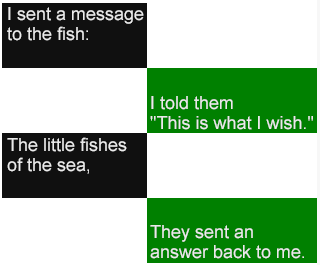 |
Note:
The semantics of the style property represented by this attribute are
based upon that defined by [XSL 1.0], § 7.13.4.
8.2.7 tts:dynamicFlow
The tts:dynamicFlow attribute is used to specify a style
property that defines how to dynamically flow content into and out of a
region over some time interval.
This style property applies only to a region when the
tts:overflow property for that region has the value
dynamic.
This attribute may be specified by any style specification element or
content element that permits use of attributes in the TT Style Namespace;
however, this attribute applies as a style property only to those element
types indicated in the following table.
| Values: |
auto | ( <flowUnit>
<flowStyle>? ){1,3} ( <duration>{1,2} )? |
| Initial: |
visible |
| Applies to: |
region |
| Inherited: |
no |
| Animatable: |
none |
If the value of this attribute consists of one <flowUnit>, then
content is cleared from, flowed within, and filled into the region using the
specified unit of flow and optional style of flow.
If the value of this attribute consists of two <flowUnit> values,
then the first value specifies the unit of flow and optional style of flow
for content cleared from the region, while the second specifies the unit of
flow and optional style of flow for content flowed within and filled into the
region.
If three values are specified, then the first specifies the units and
manner of clearing from, the second specifies the units and manner of flowing
within, and the third specifies the units and manner of filling into the
region.
If a <flowStyle> is not specified for one of the three flow values,
then a flow style of jump applies.
If one <duration> value is specified, then it denotes the time
interval to wait between dynamic fill insertions. If two <duration>
values are specified, then the second denotes the time interval to wait prior
to clearing content from and flowing content within the region after the
region has become full as a result of a dynamic fill insertion. The former
<duration> is referred to as the fill interval, while the
latter is referred to as the inter-fill interval.
The tts:dynamicFlow style is illustrated by the following
example.
Example Fragment – Dynamic Flow
<region id="r1">
<style tts:extent="240px 117px"/>
<style tts:backgroundColor="black"/>
<style tts:color="yellow"/>
<style tts:fontFamily="proportional-sans-serif"/>
<style tts:fontSize="18px"/>
<style tts:overflow="dynamic"/>
<style tts:dynamicFlow="glyph smooth"/>
</region>
...
<div region="r1">
The quick brown fox jumps over the lazy dog. The quick brown fox
jumps over the lazy dog. The quick brown fox jumps over the lazy
dog. The quick brown fox jumps over the lazy dog. The quick brown
fox jumps over the lazy dog.
</div>
|
| Editorial note: GA |
2005-02-02 |
| The semantics of this style
property needs more elaboration combined with visual examples. |
8.2.8
tts:extent
The tts:extent attribute is used to specify the
width and height of a region area.
This attribute may be specified by any style specification element or
content element that permits use of attributes in the TT Style Namespace;
however, this attribute applies as a style property only to those element
types indicated in the following table.
| Values: |
auto | <length>
<length> | inherit |
| Initial: |
auto |
| Applies to: |
tt, region |
| Inherited: |
no |
| Animatable: |
none |
If the value of this attribute consists of two <length>
specifications, then they must be interpreted as width and
height, where the first specification is the width, and the
second specification is the height.
If the value of this attribute is auto, then the initial
value of the style property must be considered to be the same as the root
container extent. The root container extent is determined either by a
tts:extent specified on the tt element, if present,
or by the external authoring context, if not present.
The tts:extent style is illustrated by the following
example.
Example Fragment – Extent
<region id="r1">
<style tts:extent="330px 122px"/>
<style tts:backgroundColor="black"/>
<style tts:color="white"/>
<style tts:displayAlign="after"/>
<style tts:textAlign="center"/>
</region>
...
<p region="r1">
'Tis the voice of the Lobster:<br/>
I heard him declare,<br/>
"You have baked me too brown,<br/>
I must sugar my hair."
</p>
|
Example Rendition – Extent
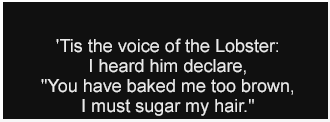 |
8.2.9 tts:fontFamily
The tts:fontFamily attribute is used to specify a style
property that defines the font family from which glyphs are selected for
glyph areas generated by content flowed into a region.
This attribute may be specified by any style specification element or
content element that permits use of attributes in the TT Style Namespace;
however, this attribute applies as a style property only to those element
types indicated in the following table.
| Values: |
(<familyName> |
<genericFamilyName>) ("," (<familyName> |
<genericFamilyName>))* | inherit |
| Initial: |
default |
| Applies to: |
span |
| Inherited: |
yes |
| Animatable: |
discrete |
Note:
For the purpose of determining applicability of this style property,
each character child of a p element is considered to be
enclosed in an anonymous span.
Note:
The initial value, default, is a generic font family name,
and is further described in 8.3.6
<genericFamilyName> below.
The tts:fontFamily style is illustrated by the following
example.
Example Fragment – Font Family
<region id="r1">
<style tts:extent="474px 146px"/>
<style tts:backgroundColor="black"/>
<style tts:color="white"/>
<style tts:displayAlign="center"/>
<style tts:textAlign="start"/>
<style tts:fontFamily="proportional-sans-serif"/>
</region>
...
<div region="r1">
<p>
"The time has come," the Walrus said,<br/>
"to talk of many things:
</p>
<p tts:textAlign="end" tts:fontFamily="monospace-serif">
Of shoes, and ships, and sealing wax,<br/>
Of cabbages and kings,
</p>
<p>
And why the sea is boiling hot,<br/>
and whether pigs have wings."
</p>
</div>
|
Example Rendition – Font Family
 |
Note:
The semantics of the style property represented by this attribute are
based upon that defined by [XSL 1.0], § 7.8.2.
8.2.10 tts:fontSize
The tts:fontSize attribute is used to specify a style
property that defines the font size for glyphs that are selected for glyph
areas generated by content flowed into a region, where font size is
interpreted as a scaling transform to the font's design EM square.
This attribute may be specified by any style specification element or
content element that permits use of attributes in the TT Style Namespace;
however, this attribute applies as a style property only to those element
types indicated in the following table.
| Values: |
<length> <length>? |
inherit |
| Initial: |
See prose |
| Applies to: |
span |
| Inherited: |
yes |
| Animatable: |
discrete |
If a single <length> value is specified, then this length applies
equally to horizontal and vertical scaling of a glyph's EM square; if two
<length> values are specified, then the first expresses the horizontal
scaling and the second expresses vertical scaling.
Note:
Use of independent horizontal and vertical font sizes is expected to be
used with cell based metrics in order to denote fonts that are two rows in
height and one column in width.
If horizontal and vertical sizes are expressed independently, then the
metrics of the <length> values must be the same.
A <length> value used to express font size must be non-negative.
The initial value of this property is defined as follows: if the value of
the ttp:defaultLengthUnit parameter is c or
em, then the initial value of tts:fontSize is
1c; otherwise the initial value is the same as the height of the
root container region.
Note:
For the purpose of determining applicability of this style property,
each character child of a p element is considered to be
enclosed in an anonymous span.
The tts:fontSize style is illustrated by the following
example.
Example Fragment – Font Size
<region id="r1">
<style tts:extent="299px 97px"/>
<style tts:backgroundColor="black"/>
<style tts:color="white"/>
<style tts:displayAlign="center"/>
<style tts:textAlign="center"/>
<style tts:fontFamily="proportional-sans-serif"/>
<style tts:fontSize="18px"/>
</region>
...
<p region="r1">
Then fill up the glasses<br/>
with treacle and ink,<br/>
Or anything else<br/>
that is <span tts:fontSize="24px">pleasant</span> to drink.
</p>
|
Example Rendition – Font Size
 |
Note:
The semantics of the style property represented by this attribute are
based upon that defined by [XSL 1.0], § 7.8.4.
8.2.11 tts:fontStyle
The tts:fontStyle attribute is used to specify a style
property that defines the font style to apply to glyphs that are selected for
glyph areas generated by content flowed into a region, where the mapping from
font style value to specific font face or style parameterization is not
determined by this specification.
This attribute may be specified by any style specification element or
content element that permits use of attributes in the TT Style Namespace;
however, this attribute applies as a style property only to those element
types indicated in the following table.
| Values: |
normal | italic |
oblique | reverse-oblique |
inherit |
| Initial: |
normal |
| Applies to: |
span |
| Inherited: |
yes |
| Animatable: |
discrete |
Note:
For the purpose of determining applicability of this style property,
each character child of a p element is considered to be
enclosed in an anonymous span.
The tts:fontStyle style is illustrated by the following
example.
Example Fragment – Font Style
<region id="r1">
<style tts:extent="331px 84px"/>
<style tts:backgroundColor="black"/>
<style tts:color="white"/>
<style tts:displayAlign="after"/>
<style tts:textAlign="center"/>
<style tts:fontFamily="proportional-sans-serif"/>
</region>
...
<p region="r1">
In autumn, when the leaves are brown,<br/>
Take pen and ink, and <span tts:fontStyle="italic">write it down.</span>
</p>
|
Example Rendition – Font Style
 |
Note:
The semantics of the style property represented by this attribute are
based upon that defined by [XSL 1.0], § 7.8.7.
8.2.12 tts:fontWeight
The tts:fontWeight attribute is used to specify a style
property that defines the font weight to apply to glyphs that are selected
for glyph areas generated by content flowed into a region, where the mapping
from font weight value to specific font face or weight parameterization is
not determined by this specification.
This attribute may be specified by any style specification element or
content element that permits use of attributes in the TT Style Namespace;
however, this attribute applies as a style property only to those element
types indicated in the following table.
| Values: |
normal | bold |
inherit |
| Initial: |
normal |
| Applies to: |
span |
| Inherited: |
yes |
| Animatable: |
discrete |
Note:
For the purpose of determining applicability of this style property,
each character child of a p element is considered to be
enclosed in an anonymous span.
The tts:fontWeight style is illustrated by the following
example.
Example Fragment – Font Weight
<region id="r1">
<style tts:extent="376px 95px"/>
<style tts:backgroundColor="black"/>
<style tts:color="white"/>
<style tts:displayAlign="center"/>
<style tts:textAlign="center"/>
<style tts:fontFamily="proportional-sans-serif"/>
</region>
...
<p region="r1">
They told me you had been to her,<br/>
<span tts:fontWeight="bold">and mentioned me to him:</span><br/>
She gave me a good character<br/>
<span tts:fontWeight="bold">but said I could not swim.</span>
</p>
|
Example Rendition – Font Weight
 |
Note:
The semantics of the style property represented by this attribute are
based upon that defined by [XSL 1.0], § 7.8.9.
8.2.13 tts:lineHeight
The tts:lineHeight attribute is used to specify a style
property that defines the inter-baseline separation between line areas
generated by content flowed into a region.
This attribute may be specified by any style specification element or
content element that permits use of attributes in the TT Style Namespace;
however, this attribute applies as a style property only to those element
types indicated in the following table.
| Values: |
normal | <length> |
inherit |
| Initial: |
normal |
| Applies to: |
p |
| Inherited: |
yes |
| Animatable: |
discrete |
If the value of this attribute is normal, then the initial
value of the style property must be considered to be the same as the largest
font size that applies to any child element.
If specified as a <length>, then the length must be
non-negative.
The tts:lineHeight style is illustrated by the following
example.
Example Fragment – Line Height
<region id="r1">
<style tts:extent="255px 190px"/>
<style tts:backgroundColor="black"/>
<style tts:color="white"/>
<style tts:displayAlign="center"/>
<style tts:textAlign="start"/>
<style tts:fontFamily="proportional-sans-serif"/>
<style tts:fontSize="16px"/>
<style tts:lineHeight="32px"/>
</region>
...
<p region="r1">
He thought he saw an elephant,<br/>
That practised on a fife:<br/>
He looked again, and found it was<br/>
A letter from his wife.<br/>
"At length I realise," he said,<br/>
"The bitterness of Life."</p>
|
Example Rendition – Line Height
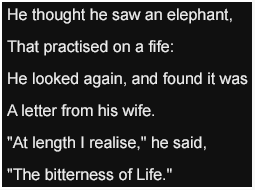 |
Note:
The semantics of the style property represented by this attribute are
based upon that defined by [XSL 1.0], § 7.15.4.
8.2.14
tts:opacity
The tts:opacity attribute is used to specify a style property
that defines the opacity (or transparency) of marks associated with a region
(such as a region's background color) or marks associated with areas
generated by a given content element to which opacity applies.
When presented onto a visual medium, the opacity of the affacted element
is applied uniformly to all marks produced by the affected element (and its
descendants).
This attribute may be specified by any style specification element or
content element that permits use of attributes in the TT Style Namespace;
however, this attribute applies as a style property only to those element
types indicated in the following table.
| Values: |
<alpha> | inherit |
| Initial: |
1.0 |
| Applies to: |
region |
| Inherited: |
no |
| Animatable: |
discrete |
An <alpha> value greater than 1.0 must be considered equivalent to
an <alpha> value of 1.0.
The tts:opacity style is illustrated by the following
example.
Example Fragment – Opacity
<region id="r1" dur="5">
<set begin="0" dur="1" tts:opacity="1.00"/>
<set begin="1" dur="1" tts:opacity="0.75"/>
<set begin="2" dur="1" tts:opacity="0.50"/>
<set begin="3" dur="1" tts:opacity="0.25"/>
<set begin="4" dur="1" tts:opacity="0.00"/>
<style tts:extent="304px 77px"/>
<style tts:backgroundColor="black"/>
<style tts:color="white"/>
<style tts:displayAlign="after"/>
<style tts:textAlign="center"/>
</region>
...
<p region="r1">
The sun was shining on the sea
</p>
|
Example Rendition – Opacity
 |
 |
 |
 |
 |
Note:
The semantics of the style property represented by this attribute are
based upon that defined by [CSS3 Color], §
3.2.
8.2.15
tts:origin
The tts:origin attribute is used to specify the x
and y coordinates of the origin of a region area with respect to the
origin of the root container extent, if specified, or the external authoring
context, if not specified.
This attribute may be specified by any style specification element or
content element that permits use of attributes in the TT Style Namespace;
however, this attribute applies as a style property only to those element
types indicated in the following table.
| Values: |
auto | <length>
<length> | inherit |
| Initial: |
auto |
| Applies to: |
region |
| Inherited: |
no |
| Animatable: |
none |
If the value of this attribute consists of two <length>
specifications, then they must be interpreted as x and y
coordinates, where the first specification is the x coordinate, and
the second specification is the y coordinate.
If the value of this attribute is auto, then the initial
value of the style property must be considered to be the same as the root
container origin. The root container origin is determined by the external
authoring context.
The tts:origin style is illustrated by the following
example.
Example Fragment – Origin
<region id="r1">
<style tts:origin="40px 40px"/>
<style tts:extent="308px 92px"/>
<style tts:backgroundColor="black"/>
<style tts:color="white"/>
<style tts:displayAlign="ceqnter"/>
<style tts:textAlign="center"/>
</region>
...
<p region="r1">
"To dine!" she shrieked in dragon-wrath.<br/>
"To swallow wines all foam and froth!<br/>
To simper at a table-cloth!"
</p>
|
Example Rendition – Origin
 |
8.2.16 tts:overflow
The tts:overflow attribute is used to specify a style
property that defines whether a region area is clipped or not if the
descendant areas of the region overflow its extent.
This attribute may be specified by any style specification element or
content element that permits use of attributes in the TT Style Namespace;
however, this attribute applies as a style property only to those element
types indicated in the following table.
| Values: |
visible | hidden
| dynamic | inherit |
| Initial: |
hidden |
| Applies to: |
region |
| Inherited: |
no |
| Animatable: |
none |
If the value of this attribute is visible, then content
should not be clipped outside of the affected region, and region composition
and layout must be performed as if the region's width and height were
infinite, but with a well-defined origin. If the value is
hidden, then content should be clipped outside of the affected
region.
Note:
Unless a manual line break element br is used by the
content author, a paragraph of a given region will generate no more than
one line area in that region if the value of the tts:overflow
style that applies to the region is visible.
If the value of this attribute is dynamic, then content is
dynamically flowed into and out of the affected region according to the
values of the tts:dynamicFlow style property; in this case, the
semantics of the tts:dynamicFlow apply whether or not the
affected region has overflowed.
The tts:overflow style is illustrated by the following
example.
Example Fragment – Overflow
<region id="r1">
<style tts:extent="232px 40px"/>
<style tts:origin="0px 0px"/>
<style tts:backgroundColor="black"/>
<style tts:color="red"/>
<style tts:displayAlign="before"/>
<style tts:textAlign="start"/>
<style tts:fontFamily="proportional-sans-serif"/>
<style tts:fontSize="18px"/>
<style tts:wrapOption="noWrap"/>
<style tts:overflow="visible"/>
</region>
<region id="r2">
<style tts:extent="232px 40px"/>
<style tts:origin="0px 43px"/>
<style tts:backgroundColor="black"/>
<style tts:color="red"/>
<style tts:displayAlign="before"/>
<style tts:textAlign="start"/>
<style tts:fontFamily="proportional-sans-serif"/>
<style tts:fontSize="18px"/>
<style tts:wrapOption="noWrap"/>
<style tts:overflow="hidden"/>
</region>
...
<p region="r1">
"But wait a bit," the Oysters cried,<br/>
"Before we have our chat;
</p>
<p region="r2">
For some of us are out of breath,<br/>
And all of us are fat!"
</p>
|
Example Rendition – Overflow
 |
Note:
In the above example, the tts:noWrap is set to
noWrap to prevent automatic line wrapping (breaking); if this
were not specified, then overflow would occur in the block progression
direction as opposed to the inline progression direction.
Note:
The semantics of the style property represented by this attribute are
based upon that defined by [XSL 1.0], § 7.20.2.
8.2.17
tts:padding
The tts:padding attribute is used to specify padding (or
inset) space on all sides of a region area or a content area produced by a
content element.
This attribute may be specified by any style specification element or
content element that permits use of attributes in the TT Style Namespace;
however, this attribute applies as a style property only to those element
types indicated in the following table.
| Values: |
<length> | <length>
<length> | <length> <length> <length>
<length> | inherit |
| Initial: |
0 |
| Applies to: |
region |
| Inherited: |
no |
| Animatable: |
discrete |
If the value of this attribute consists of one <length>
specification, then that length applies to all edges of the affected areas.
If the value consists of two <length> specifications, then the first
applies to the before and after edges, and the second applies to the start
and end edges. If four <length> specifications are provided, then they
apply to before, end, after, and start edges, respectively.
The tts:padding style is illustrated by the following
example.
Example Fragment – Padding
<region id="r1">
<style tts:extent="446px 104px"/>
<style tts:backgroundColor="black"/>
<style tts:color="white"/>
<style tts:displayAlign="after"/>
<style tts:textAlign="center"/>
<style tts:padding="10px 40px"/>
</region>
...
<p region="r1" tts:backgroundColor="red">
Just the place for a Snark! I have said it twice:<br/>
That alone should encourage the crew.<br/>
Just the place for a Snark! I have said it thrice:<br/>
What I tell you three times is true.
</p>
|
When rendering an area to which padding applies, the background color that
applies to the area is rendered into the padded portion of the area.
Example Rendition – Padding
 |
8.2.18 tts:showBackground
The tts:showBackground attribute is used to specify
constraints on when the background color of a region is intended to be
presented.
This attribute may be specified by any style specification element or
content element that permits use of attributes in the TT Style Namespace;
however, this attribute applies as a style property only to those element
types indicated in the following table.
| Values: |
always |
whenActive | inherit |
| Initial: |
always |
| Applies to: |
region |
| Inherited: |
no |
| Animatable: |
discrete |
If the value of this attribute is always, then the background
color of a region is always rendered when performing presentation processing
on a visual medium; if the value is whenActive, then the
background color of a region is rendered only when some content is selected
into the region.
The tts:showBackground style is illustrated by the following
example.
Example Fragment – Show Background
<region id="r1">
<style tts:origin="0px 0px"/>
<style tts:extent="265px 100px"/>
<style tts:backgroundColor="black"/>
<style tts:showBackground="always"/>
<style tts:color="white"/>
<style tts:displayAlign="before"/>
<style tts:textAlign="start"/>
</region>
<region id="r2">
<style tts:origin="205px 60px"/>
<style tts:extent="290px 100px"/>
<style tts:backgroundColor="red"/>
<style tts:color="white"/>
<style tts:displayAlign="before"/>
<style tts:textAlign="end"/>
<style tts:showBackground="whenActive"/>
</region>
|
Example Rendition – Show Background
| Editorial note: GA |
2005-01-31 |
| Supply sample
rendition; region "r1" will have a visible background while "r2"
will not. Note that no content is selected into either region in
this example. |
|
Note:
The semantics of the style property represented by this attribute are
based upon that defined by [SMIL2], § 5.3.1.
8.2.19 tts:textAlign
The tts:textAlign attribute is used to specify a style
property that defines how inline areas are aligned within a containing block
area in the inline progression direction.
This attribute may be specified by any style specification element or
content element that permits use of attributes in the TT Style Namespace;
however, this attribute applies as a style property only to those element
types indicated in the following table.
| Values: |
start | center |
end | inherit |
| Initial: |
start |
| Applies to: |
p |
| Inherited: |
yes |
| Animatable: |
discrete |
The tts:textAlign style is illustrated by the following
example.
Example Fragment – Text Align
<region id="r1">
<style tts:extent="355px 43px"/>
<style tts:origin="0px 0px"/>
<style tts:backgroundColor="black"/>
<style tts:color="white"/>
<style tts:textAlign="start"/>
</region>
<region id="r2">
<style tts:extent="355px 43px"/>
<style tts:origin="0px 47px"/>
<style tts:backgroundColor="black"/>
<style tts:color="white"/>
<style tts:textAlign="end"/>
</region>
...
<p region="r1">
Beware the Jabberwock, my son!<br/>
The jaws that bite, the claws that catch!
</p>
<p region="r2">
Beware the Jubjub bird, and shun<br/>
The frumious Bandersnatch!
</p>
|
Example Rendition – Text Align
 |
Note:
The semantics of the style property represented by this attribute are
based upon that defined by [XSL 1.0], § 7.15.9.
8.2.20 tts:textOutline
The tts:textOutline attribute is used to specify a style
property that defines a text outline effect to apply to glyphs that are
selected for glyph areas generated by content flowed into a region.
This attribute may be specified by any style specification element or
content element that permits use of attributes in the TT Style Namespace;
however, this attribute applies as a style property only to those element
types indicated in the following table.
| Values: |
none | <color>?
<length> <length>? inherit |
| Initial: |
none |
| Applies to: |
span |
| Inherited: |
yes |
| Animatable: |
discrete |
Note:
For the purpose of determining applicability of this style property,
each character child of a p element is considered to be
enclosed in an anonymous span.
The value of this attribute consists of an optional <color> term
followed by one or two <length> terms. If a color term is
present, then it denotes the outline color; if no color term is
present, the computed value of the tts:color applies. The first
length term denotes the outline thickness and the second length
term, if present, indicates the blur radius.
The tts:textOutline style is illustrated by the following
example.
Example Fragment – Text Outline
<region id="r1">
<style tts:backgroundColor="transparent"/>
<style tts:color="yellow"/>
<style tts:textOutline="black 2px 0px"/>
<style tts:fontFamily="proportional-sans-serif"/>
<style tts:fontSize="24px"/>
</region>
...
<p>
How doth the little crocodile<br/>
Improve its shining tail,<br/>
And pour the waters of the Nile<br/>
On every golden scale!<br/>
How cheerfully he seems to grin,<br/>
How neatly spreads his claws,<br/>
And welcomes little fishes in,<br/>
With gently smiling jaws!
</p>
|
Example Rendition – Text Outline
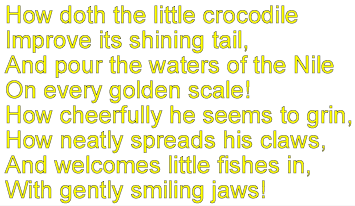 |
8.2.21 tts:unicodeBidi
The tts:unicodeBidi attribute is used to specify a style
property that defines a directional embedding or override according to the
Unicode bidirectional algorithm.
This attribute may be specified by any style specification element or
content element that permits use of attributes in the TT Style Namespace;
however, this attribute applies as a style property only to those element
types indicated in the following table.
| Values: |
normal | embed |
bidiOverride | inherit |
| Initial: |
normal |
| Applies to: |
span |
| Inherited: |
no |
| Animatable: |
none |
The tts:unicodeBidi style is illustrated by the following
example.
Example Rendition – Unicode Bidirectionality
| Editorial note: GA |
2005-02-22 |
Provide example source
fragment and image for tts:unicodeBidi style
property. |
|
Note:
The semantics of the style property represented by this attribute are
based upon that defined by [XSL 1.0], § 7.27.6.
8.2.22 tts:visibility
The tts:visibility attribute is used to specify a style
property that defines whether generated areas are visible or not when
rendered on a visual presentation medium.
This attribute may be specified by any style specification element or
content element that permits use of attributes in the TT Style Namespace;
however, this attribute applies as a style property only to those element
types indicated in the following table.
| Values: |
visible | hidden
| inherit |
| Initial: |
visible |
| Applies to: |
region, body,
div, p, span |
| Animatable: |
discrete |
| Animatable: |
discrete |
The tts:visibility style has no affect on content layout or
composition, but merely determines whether composed content is visible or
not.
The tts:visibility style is illustrated by the following
example.
Example Fragment – Visibility
<region id="r1">
<style tts:extent="398px 121px"/>
<style tts:backgroundColor="black"/>
<style tts:color="white"/>
<style/>
</region>
...
<p region="r1" dur="4" tts:visibility="hidden">
<span>
<set begin="1" tts:visibility="visible"/>
Curiouser
</span>
<span>
<set begin="2" tts:visibility="visible"/>
and
</span>
<span>
<set begin="3" tts:visibility="visible"/>
curiouser!
</span>
</p>
|
Example Rendition – Visibility
 |
 |
 |
 |
Note:
The semantics of the style property represented by this attribute are
based upon that defined by [XSL 1.0], § 7.28.8.
8.2.23 tts:wrapOption
The tts:wrapOption attribute is used to specify a style
property that defines whether or not automatic line wrapping (breaking)
applies within the context of the affected element.
This attribute may be specified by any style specification element or
content element that permits use of attributes in the TT Style Namespace;
however, this attribute applies as a style property only to those element
types indicated in the following table.
| Values: |
wrap | no-wrap |
inherit |
| Initial: |
wrap |
| Applies to: |
span |
| Inherited: |
yes |
| Animatable: |
discrete |
For the purpose of determining applicability of this style property, each
character child of a p element is considered to be enclosed in
an anonymous span.
The tts:wrapOption style is illustrated by the following
example.
Example Fragment – Wrap Option
<region id="r1">
<style tts:extent="192px 117px"/>
<style tts:backgroundColor="black"/>
<style tts:color="white"/>
<style tts:displayAlign="after"/>
<style tts:overflow="hidden"/>
<style tts:wrapOption="noWrap"/>
</region>
...
<p>
I'll tell thee everything I can:<br/>
There's little to relate.<br/>
I saw an aged aged man,<br/>
A-sitting on a gate."
</p>
|
Example Rendition – Wrap Option
 |
Note:
The semantics of the style property represented by this attribute are
based upon that defined by [XSL 1.0], § 7.15.13.
8.2.24 tts:writingMode
The tts:writingMode attribute is used to specify a style
property that defines the block and inline progression directions to be used
for the purpose of stacking block and inline areas within a region area.
This attribute may be specified by any style specification element or
content element that permits use of attributes in the TT Style Namespace;
however, this attribute applies as a style property only to those element
types indicated in the following table.
| Values: |
lrtb | rltb |
tbrl | tblr | lr |
rl | tb | inherit |
| Initial: |
lr-tb |
| Applies to: |
region |
| Inherited: |
no |
| Animatable: |
none |
The tts:writingMode style is illustrated by the following
example.
Example Fragment – Writing Mode
<region id="r1">
<style tts:extent="50px 570px"/>
<style tts:origin="0px 0px"/>
<style tts:padding="10px 3px"/>
<style tts:backgroundColor="black"/>
<style tts:color="white"/>
<style tts:writingMode="tbrl"/>
</region>
<region id="r2">
<style tts:extent="310px 50px"/>
<style tts:origin="70px 120px"/>
<style tts:padding="10px 3px"/>
<style tts:backgroundColor="black"/>
<style tts:color="white"/>
<style tts:writingMode="rltb"/>
</region>
...
<p region="r1">
I sometimes dig for buttered rolls,<br/>
Or set limed twigs for crabs:
</p>
<p region="r2" tts:direction="rtl" tts:unicodeBidi="bidiOverride">
I sometimes search the grassy knolls for the wheels of Hansom-cabs.
</p>
|
Example Rendition – Writing Mode
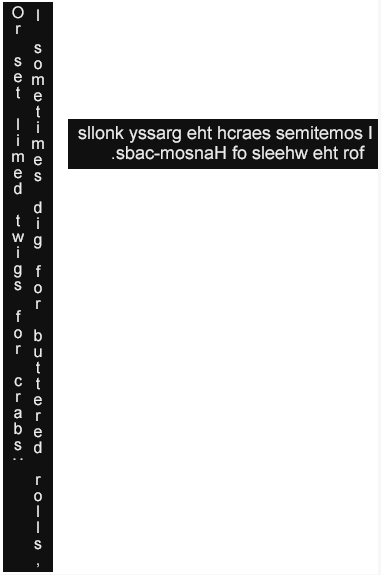 |
Note:
In the second paragraph in the above example that targets region
r2, the tts:unicodeBidi and
tts:direction properties are set to bidiOverride
and rtl, respectively, in order to override the normally
left-to-right directionality of characters in the Latin script.
Note:
The semantics of the style property represented by this attribute are
based upon that defined by [XSL 1.0], § 7.27.7.
8.2.25
tts:zIndex
The tts:zIndex attribute is used to specify a style property
that defines the front-to-back ordering of region areas in the case that they
overlap.
This attribute may be specified by any style specification element or
content element that permits use of attributes in the TT Style Namespace;
however, this attribute applies as a style property only to those element
types indicated in the following table.
| Values: |
<integer> | inherit |
| Initial: |
0 |
| Applies to: |
region |
| Inherited: |
no |
| Animatable: |
discrete |
If two areas are associated with the same Z-index value, then, if those
areas overlap in space, the area(s) generated by lexically subsequent
elements must be rendered over area(s) generated by lexically prior elements,
where lexical order is defined as the postorder traversal of a document
instance.
The tts:zIndex style is illustrated by the following
example.
Example Fragment – Z Index
<region id="r1">
<style tts:origin="0px 0px"/>
<style tts:extent="400px 100px"/>
<style tts:padding="5px"/>
<style tts:backgroundColor="black"/>
<style tts:color="white"/>
<style tts:zIndex="0"/>
</region>
<region id="r2">
<style tts:origin="100px 60px"/>
<style tts:extent="400px 100px"/>
<style tts:padding="5px"/>
<style tts:backgroundColor="red"/>
<style tts:color="white"/>
<style tts:textAlign="end"/>
<style tts:zIndex="1"/>
</region>
<region id="r3">
<style tts:origin="0px 120px"/>
<style tts:extent="400px 100px"/>
<style tts:padding="5px"/>
<style tts:backgroundColor="black"/>
<style tts:color="white"/>
<style tts:zIndex="2"/>
</region>
<region id="r4">
<style tts:origin="100px 180px"/>
<style tts:extent="400px 100px"/>
<style tts:padding="5px"/>
<style tts:backgroundColor="red"/>
<style tts:color="white"/>
<style tts:textAlign="end"/>
<style tts:zIndex="3"/>
</region>
...
<p region="r1">
I passed by his garden, and marked, with one eye,<br/>
How the Owl and the Panther were sharing a pie.
</p>
<p region="r2">
The Panther took pie-crust, and gravy, and meat,<br/>
While the Owl had the dish as its share of the treat.
</p>
<p region="r3">
When the pie was all finished, the Owl, as a boon,<br/>
Was kindly permitted to pocket the spoon:
</p>
<p region="r4">
While the Panther received knife and fork<br/>
with a growl,<br/>
And concluded the banquet by...
</p>
|
Example Rendition – Z Index
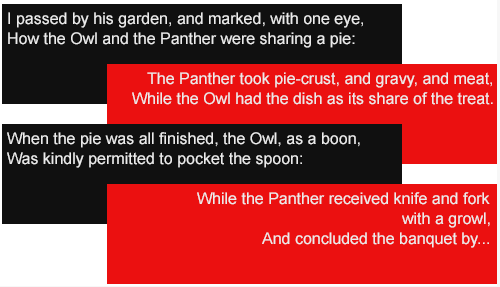 |
Note:
The semantics of the style property represented by this attribute are
based upon that defined by [XSL 1.0], § 7.28.9.









































